Anomalous constitutive Src kinase activity promotes B lymphoma survival and growth
- PMID: 20043832
- PMCID: PMC2814804
- DOI: 10.1186/1476-4598-8-132
Anomalous constitutive Src kinase activity promotes B lymphoma survival and growth
Abstract
Background: Previously we have shown that B cell receptor (BCR) expression and B cell receptor signaling pathways are important for the basal growth of B lymphoma cells. In particular we have shown that the activation of Syk, a non-src family protein tyrosine kinase and the mitogen activated protein kinases (MAPK), ERK and JNK that mediate BCR signals are required for the constitutive growth of B lymphoma cells. Since src family protein tyrosine kinases (SFKs) like Lyn are known to be needed for the phosphorylation of BCR co-receptors, Ig-alpha and Ig-beta, we hypothesized that one or more SFKs will be constitutively activated in B lymphoma cells and may be necessary for B lymphoma growth.
Results: Src kinase activity was found to be constitutively high in many murine and human B lymphoma cell lines and primary lymphoma samples. The specific pharmacological inhibitors of SFKs, PP1 and PP2 inhibited the proliferation of a number of both murine and human B lymphomas in a dose-dependent manner. Importantly, dasatinib (BMS-354825), an oral dual BCR-ABL and SFK specific inhibitor inhibited the growth of B lymphomas in the nanomolar range in vitro and strongly inhibited a mouse lymphoma growth in vivo. Among the SFKs, Lyn is predominantly phosphorylated and Lyn-specific small interfering RNA inhibited the growth of B lymphomas, supporting an important role for Lyn in B lymphoma growth. Suppression of SFK activity blocks BCR mediated signaling pathways. PMA or CpG can partially reverse the growth inhibition induced by SFK inhibition. Although blocking SFK activity inhibited the growth of a number of B lymphomas, some lymphomas such as SudHL-4, SudHL-6, OCI-Ly3 and OCI-Ly10 are more resistant due to an increased expression of the anti-apoptotic proteins Bcl-2 and Bcl-xL.
Conclusions: These studies further support our concept that BCR signaling pathways are important for the continued growth of established B lymphoma cells. Some of the intermediates in this BCR pathway are potential immunotherapeutic targets. In particular, inhibition of SFK activity alone or in synergy with inhibition of the prosurvival Bcl-2 proteins holds promise in developing more effective treatments for B lymphoma patients.
Figures
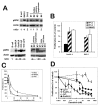

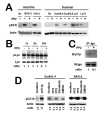
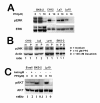
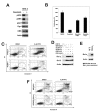
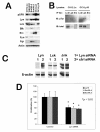

Similar articles
-
Inhibition of Src family kinases with dasatinib blocks migration and invasion of human melanoma cells.Mol Cancer Res. 2008 Nov;6(11):1766-74. doi: 10.1158/1541-7786.MCR-08-0169. Mol Cancer Res. 2008. PMID: 19010823 Free PMC article.
-
Dasatinib (BMS-354825) inhibits Stat5 signaling associated with apoptosis in chronic myelogenous leukemia cells.Mol Cancer Ther. 2007 Apr;6(4):1400-5. doi: 10.1158/1535-7163.MCT-06-0446. Mol Cancer Ther. 2007. PMID: 17431118
-
Action of the Src family kinase inhibitor, dasatinib (BMS-354825), on human prostate cancer cells.Cancer Res. 2005 Oct 15;65(20):9185-9. doi: 10.1158/0008-5472.CAN-05-1731. Cancer Res. 2005. PMID: 16230377
-
Expression of protein tyrosine kinases in the Ig complex of anti-mu-sensitive and anti-mu-resistant B-cell lymphomas: role of the p55blk kinase in signaling growth arrest and apoptosis.Immunol Rev. 1993 Apr;132:163-86. doi: 10.1111/j.1600-065x.1993.tb00842.x. Immunol Rev. 1993. PMID: 8349295 Review.
-
Apoptosis regulation by the tyrosine-protein kinase CSK.Front Cell Dev Biol. 2022 Dec 12;10:1078180. doi: 10.3389/fcell.2022.1078180. eCollection 2022. Front Cell Dev Biol. 2022. PMID: 36578781 Free PMC article. Review.
Cited by
-
Role of B cell receptor signaling in IL-10 production by normal and malignant B-1 cells.Ann N Y Acad Sci. 2015 Dec;1362(1):239-249. doi: 10.1111/nyas.12802. Epub 2015 Jun 11. Ann N Y Acad Sci. 2015. PMID: 26096907 Free PMC article.
-
A Novel Peptide that Disrupts the Lck-IP3R Protein-Protein Interaction Induces Widespread Cell Death in Leukemia and Lymphoma.Arch Microbiol Immunol. 2023;7(3):165-177. doi: 10.26502/ami.936500114. Epub 2023 Aug 30. Arch Microbiol Immunol. 2023. PMID: 37829571 Free PMC article.
-
Anti-cancer activity of withaferin A in B-cell lymphoma.Cancer Biol Ther. 2015;16(7):1088-98. doi: 10.1080/15384047.2015.1046651. Cancer Biol Ther. 2015. PMID: 26020511 Free PMC article.
-
Spleen Tyrosine Kinase Inhibitor TAK-659 Prevents Splenomegaly and Tumor Development in a Murine Model of Epstein-Barr Virus-Associated Lymphoma.mSphere. 2018 Aug 22;3(4):e00378-18. doi: 10.1128/mSphereDirect.00378-18. mSphere. 2018. PMID: 30135222 Free PMC article.
-
A novel orally available Syk/Src/Jak2 inhibitor, SKLB-850, showed potent anti-tumor activities in B cell lymphoma (BCL) models.Oncotarget. 2017 Dec 1;8(67):111495-111507. doi: 10.18632/oncotarget.22847. eCollection 2017 Dec 19. Oncotarget. 2017. PMID: 29340070 Free PMC article.
References
-
- Gururajan M, Jennings CD, Bondada S. Cutting edge: constitutive B cell receptor signaling is critical for basal growth of B lymphoma. J Immunol. 2006;176:5715–5719. - PubMed
Publication types
MeSH terms
Substances
Grants and funding
LinkOut - more resources
Full Text Sources
Other Literature Sources
Research Materials
Miscellaneous

